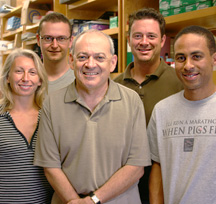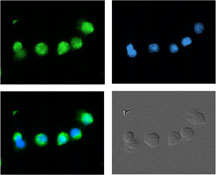

Scripps Research Team Reverses Friedreich's Ataxia Defect in Cell Culture
By Mark Schrope
A team from The Scripps Research Institute and the University of California School of Medicine has developed compounds that reactivate the gene responsible for the neurodegenerative disease Friedreich's ataxia, offering hope for an effective treatment for this devastating and often deadly condition.
The results of the research are being published on August 20 in an advanced, online version of the journal Nature Chemical Biology.
In the new study, the researchers tested a variety of compounds that inhibited a class of enzymes known as histone deacetylases in a cell line derived from blood cells from a Fredreich's ataxia sufferer. One of these inhibitors had the effect of reactivating the frataxin gene, which is silenced in those with the disease. The researchers then went on to improve on this molecule by synthesis of novel derivatives, identifying compounds that would reactivate the frataxin gene in blood cells taken from 13 Friedreich's ataxia patients.
In fact, one of the compounds the researchers tested produced what amounted to full reactivation of the frataxin gene in 100 percent of cells tested.
"This is marvelous," said Joel Gottesfeld, a professor in the Scripps Research Department of Molecular Biology and leader of the project. "I've met the parents of many children affected with the disease and some of the patients and it would be just a dream to be able to help them."
"Dr. Gottesfeld's work holds tremendous promise of real therapeutic benefit for Friedreich's ataxia patients," said Ron Bartek, president of Friedreich's Ataxia Research Alliance (FARA). "This discovery appears to be our only near-term prospect for significantly increasing transcription of the frataxin gene. FARA is pleased to have been able to support this important work."
Friedreich's Ataxia, a Debilitating Disease
About one of every 20,000 to50,000 people in the United States has Friedreich's ataxia, which is caused by a genetic defect that prevents adequate production of the protein frataxin. In neuronal and muscle cells, frataxin is essential for proper functioning of mitochondria, the energy producers for cells. Low levels of the protein lead to degeneration of nerve tissue in the spinal cord and nerves controlling muscle movement in the arms and legs.
Specific symptoms, which typically first appear between the ages of five and 15, include trouble walking, reduced hand coordination, and slurred speech. The disease also typically leads to scoliosis, heart disease, and diabetes. Most Friedreich's ataxia sufferers are eventually confined to a wheelchair and die as early adults due to associated heart disease.
The genetic defect involves numerous extra repeats of a GAA-TTC triplet pattern in a person's DNA that prevent expression of the frataxin gene. Where normal cells contain 6 to 34 repeats, Friedreich's ataxia sufferers can have as many as 1,700. The more triplets a person's DNA contains, the earlier symptoms appear and the greater their severity. Several other diseases, including Huntington's disease and the spinocerebellar ataxias,are also linked to triplet repeats.
Only individuals who carry the Friedreich's ataxia defect on both of their paired alleles—i.e., who are homozygous for the trait—suffer from the condition. Those individuals who are heterozygous, with only one defective allele, produce about half the normal level of frataxin, but do not suffer disease symptoms. This suggests that a treatment for Friedreich's ataxia need not raise frataxin production all the way to normal levels to be effective.
Gottesfeld notes that the repeats causing Friedreich's ataxia are in a region of the gene that does not code for the protein frataxin, so reversing gene silencing may be all that is needed to treat the disease.
A New Theory
Researchers are still working to understand the reasons the triplet repeats prevent transcription of the frataxin gene, although the gene itself remains intact. Although other theories have been proposed, the new research supports an explanation known as the "histone code theory."
Histones are proteins that are the chief constituent of the nucleosomes around which DNA is wrapped in cells. The new theory suggests that histones must contain certain chemical cues, including acetyl groups, for nucleosomes to assume the formation that allows the genes they package to be expressed.
One idea suggested by the paper's authors is that the triplets cause an unusual DNA structure that attracts proteins such as histone deacetylases (HDACs), removing critical acetyl groups from the histones, packaging the histones in an inactive form called heterochromatin, and ultimately leading to silencing of the frataxin gene.
Based on this theory, Gottesfeld and his colleagues began looking for compounds that might block the HDACs with the goal of reactivating frataxin production. The researchers were able to draw from a range of commercially available products because many HDAC inhibitors have been developed as tools for molecular biology research and as potential cancer treatments.
Though Friedreich's ataxia impacts neuronal and muscle cells, these are not readily available for research. So, the group instead worked with white blood cells, or lymphyocytes, which are easily obtained from blood samples and can be prevented from dividing, making them a suitable proxy.
Experiments revealed that one HDAC inhibitor, called BML-210, did in fact reverse the heterochromatin formation in cultured lymphocytes from Friedreich's ataxia patients and increased the production of frataxin messenger RNA (mRNA), a precursor to production of the protein, although not sufficiently to bring protein production to normal.
Next, the researchers chemically modified BML-210 to produce a variety of analogs whose effects on the cells were then tested. One class of analogs produced a two to three-fold increase in frataxin transcription amounting to full reactivation of the frataxin gene in an astonishing 100 percent of cells from 13 Friedreich's ataxia sufferers.
"They never failed," said Gottesfeld. Such therapeutic reactivation of a silenced gene has only been achieved for a handful of other diseases.
Importantly, the team's HDAC inhibitors have also proven uniformly non-toxic to the lymphocytes and do not significantly affect cell growth rates. Ongoing animal studies also have not revealed any toxicity. If the results of animal testing remain positive, said Gottesfeld, the HDAC inhibitors could enter human trials as a Friedreich's ataxia treatment in as soon as 18 months' time.
"FARA is truly excited about rallying additional support," Bartek noted, "so as to move Dr. Gottesfeld's compounds through preclinical drug development and into clinical trials just as quickly as possible."
Other Friedreich's ataxia treatments under development are largely aimed at better treating symptoms of the disease, rather than grappling with the root cause of low frataxin production. Additional compounds that increase expression of frataxin protein have also been developed, but are likely too toxic for therapeutic use. Gene therapies or stem cell treatments may eventually be available to increase frataxin production, but such options are probably many years off.
"Our small molecules offer a therapeutic approach to pursue in the near term," said Gottesfeld.
In addition to Gottesfeld, authors of the new study, entitled "Histone deacetylase inhibitors reverse gene silencing in Friedreich's ataxia," are David Herman, Kai Jenssen, Ryan Burnett and Elisabetta Soragni, also from Scripps Research, and Susan Perlman from the University of California School of Medicine, Los Angeles.
In addition to funding from FARA, the study was supported by grants from the National Institute of Neurological Diseases and Stroke of the National Institutes of Health.
Send comments to: mikaono[at]scripps.edu

"I've met the parents of many children affected with the disease and some of the patients and it would be just a dream to be able to help them," says Professor Joel Gottesfeld (center). Also shown, from left to right, are Research Associates Elisabetta Soragni,
Kai Jenssen, Ryan Burnett, and David Herman.

Lymphoid cells from a patient with Friedreich's Ataxia. Click for details
